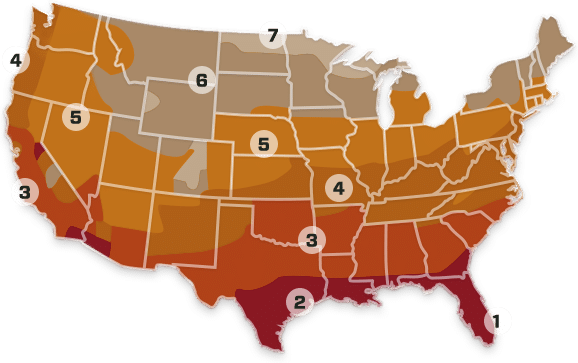Insulation 101
The following information will help you understand the different types of insulation (fiberglass, cellulose, spray foam, etc.) and what your installation options are.
MAJOR INSULATION TYPES
Here is some information about the major types of insulation.
- Batt Insulation – Common and cost-effective, batt insulation provides basic coverage for attics, walls, crawl spaces, ceilings, and basements. It’s quick and affordable and also offers sound-dampening qualities.
- Blown-in Insulation – With a high percentage of recycled content, blown-in is eco-friendly and very energy efficient. It provides a dense, effective barrier against heat loss in attics, walls, and hard-to-reach spaces.
- Spray Foam Insulation – Spray polyurethane foam (SPF) insulation is the most advanced, energy-efficient insulation and air sealant available today. TruTeam offers a nationwide team dedicated to installing this excellent energy-saving technology.
– CLOSED-CELL SPF provides added structural strength and is a hard, vapor-resistant foam that won’t need to be replaced if your home is flooded.
– OPEN-CELL SPF offers the same insulation benefits but does not act as a vapor retarder or water barrier.
- Radiant Barrier – This specialized roof insulation reduces attic temperatures by up to 30 degrees in the Summer. In warmer climates, it reflects and reduces the radiant energy of the sun by 97 percent.
- Air Sealing – All of the cracks, holes, and gaps in your home could form the equivalent of a 30-inch-wide window being open at all times. Thorough insulation begins with sealing these hidden holes with proven air sealing techniques.
INSULATION 101 QUICK FACTS
- Proper insulation and air sealing services can help you save up to 20% on your utility bills
- Batt insulation provides good R-Values as well as sound dampening. Up to 80% recycled content is available.
- Blown-in insulation provides better R-Values and better noise control. Up to 85% recycled content is available, making this an excellent choice for the environment.
- Spray foam insulation provides the best R-Values while also air sealing tiny cracks and gaps.
Recommended Insulation Levels
The map below shows the most cost-effective levels of insulation for the different climate zones in the U.S. Based on your zone, use the table to find out how much insulation you need to add if you have an uninsulated attic or if you have a few inches of existing insulation and need more for home restoration purposes.

To understand how much insulation you need, it’s important to understand R-Value, which is a measure of insulation’s ability to resist heat traveling through it. The higher the R-Value, the better the thermal performance of the insulation. The materials that measure a greater resistance to heat flow (usually because of its thickness) will have higher R-values. It may sound like a no-brainer to choose the insulation material that boasts the highest R-value. However, this is not the only determination of insulation quality. Four factors determine the quality and overall effectiveness of insulation:
- Conduction
- Convection
- Air filtration
- Radiation
Some types of spray foam, for example, may have a low R-value, and yet it is still one of the best insulation types in the industry.

How to Calculate R-value
The testing that is used to determine the R-value of material is called the “Standard Test Method for Steady-State Thermal Transmission Properties by Means of the Heat Flow Meter Apparatus,” or in short, AST C518. To determine your existing R-Value, you would multiply the inch number of your insulation by the R-Value of its particular type. Below is a chart listing the typical R-Values of the different insulation types.
| Insulation Type | R-Value |
| Fiberglass Batt Insulation | R-8 (3″) to R-38 (12″) |
| Other Batt Insulation | R-11 (3-1/2″) to R-30 (9-1/2″) |
| Fiberglass Blown-in Insulation | R-8 (3″) to R-60 (27-1/4″) |
| Cellulose Blown-In Insulation | R-8 (2″) to R-60 (18-3/4″) |
The below chart features R-Values of particular types of climates.
| Climate | R-Value |
| Warm Climates | R-30 to R-49 |
| Moderate Climates | R-38 to R-60 |
| Cold Climates | R-49 to R-60 |
Benefits of INSULATION
There are a wide range of benefits to insulation, including those listed below.
REDUCED ENERGY COSTS AND TEMPERATURE CONTROL
The greatest benefit of insulation comes down to simple economics: proper insulation means more money in your pocket. That is because efficient insulation reduces the costs of electricity bills by keeping in cool air when it is hot and keeping in warm air when it is cold. Around 42% of the typical American’s utility bill is spent on running a heater or air conditioner to maintain a comfortable temperature in the home. However, when insulation is efficient, the home stays cool in the summer and warm in the winter, reducing the need to keep expensive appliances continuously running. According to the North American Insulation Manufacturers Association (NAIMA), proper insulation can reduce your home’s heating and cooling costs up to 20%.
REDUCED NOISE AND SOUND CONTROL
Lower energy costs and comfortable temperatures in the home are not the only benefits of efficient insulation. Insulation also helps keep noise out, keeping a comfortable sound level in your home. When noise comes from outside the home, such as from traffic or neighbors, insulation within your walls can absorb the sound and reduce acoustics. When sound comes from within the home, such as from indoor appliances like television, insulation around openings in your home can act as a sound barrier and reduce the transfer of sound between rooms. This is particularly useful in multifamily living areas, such as condominium units. When sharing walls with neighbors, insulation becomes a valuable source of privacy.
Air Quality Control
A benefit of air sealing is protection from allergens. Insulation that has been well-installed can serve as a barrier against outside allergens, reducing pollen and dust. Proper air sealing prevents air from polluting the home from the outside. Ideally, the only air that should find its way into your home should travel through heating, ventilation, or air conditioning systems, which are protected with air filters designed to control air content. With allergens and contaminants regulated, the overall air quality of your home stays at a high standard. Proper air sealing can also guard against insects and pests entering the building.
WHERE TO INSULATE IN YOUR HOME
There are five main locations in which you can install insulation: the attic, walls, floors, crawl space, and basement. There are different reasons for (and benefits of) insulating each area.
INSTALLATION OPTIONS
For installing insulation, you have 3 options:
- Hire a specialized insulation contractor like TruTeam directly. You can find qualified contractors by visiting websites like your local Home Builders Association, the Insulation Contractors Association of America, the Spray Polyurethane Foam Alliance, or by checking out the listings of qualified contractors on SprayFoam.com. Another option is to hire a contractor through your local home improvement retailer.
- Hire a general contractor. This is an option when you need to do a complete remodel and need new drywall installed, insulation, flooring, electrical, etc. A general contractor may subcontract the insulation installation to a company like TruTeam.
- Install the insulation yourself. If you choose the DIY route, this guide will help you get started, but you will most likely be paying more for materials and installation will take time. If you or someone you know has installation experience, make sure you are taking the proper safety precautions and prepare accordingly.
CHOOSE YOUR CONTRACTOR
Once armed with a basic understanding of insulation, you’ll need to find the right contractor to complete your installation or home remodel project. Here are some questions to ask.
What is your total cost quote for my project, including materials and labor?
Quotes for insulation installation can vary widely, so it is important to be clear exactly what is accounted for in the quote. A bid from TruTeam will include materials and labor and will be based on the coverage area. If a contractor charges a fixed rate, ask how they will handle possible additional charges after the contract is signed. If a contractor charges an hourly rate, ask for an estimate on how many hours they expect to be on site. If a contractor charges by coverage area, ask how they determine the coverage area of insulation needed.
How long do you estimate my project will take?
If you expect an insulation job to be done well, it should not be rushed. However, it is understandable to want the job done as quickly as is reasonably possible. That is why it helps to know how long an insulation project typically takes to complete. A contractor’s estimate should fall logically within that timeframe. Make sure to take into consideration any estimates that may account for different scenarios, like needing to remove old insulation.
The size of the project is also a factor. Installing in an attic will be much quicker than installing in an entire home. Below is a general chart of time frames for regular insulation jobs, not taking into account scheduling or availability.
| Typical Installation Job | Typical Timeframe |
| Attic Insulation | 1-2 days |
| Crawl Space | 2-3 hours |
| Wall Spray Foam Injection | 2-5 hours |
| Cavity Wall Blown-In | 1 day max |
Can you provide credible references, referrals, and reviews?
Word of mouth is often the most powerful testimony of good work, and it is no wonder. The references, referrals, and reviews of actual customers reveal the strengths of a particular contractor, as well as their weaknesses.
Are you familiar with the building codes and requirements for my home?
As already eluded to above, this is critical. Building codes are regulations usually set by the city that dictate the standards related to construction, design, alteration, maintenance, and safety. Buildings must conform to these codes and requirements to ensure the health and welfare of residents. It is important that the contractor you hire is familiar with your particular local building codes and needs, and that they fully adhere to them.
Are you an active member of reputable associations?
When looking to hire a contractor for your insulation needs, active membership in contractor and industry associations is an excellent quality. It shows a commitment to their trade. TruTeam is involved in several industry associations.
WHAT TO EXPECT FROM AN INSULATION CONTRACTOR
With TruTeam, an insulation representative may come to your home to identify how much insulation you have and how much you need to add for optimal insulation levels, or it can be done over the phone. A professional assessment and estimate should be free in almost all cases.
A contractor representative should help you understand the process of estimating, scheduling, and inspecting your insulation project. Expect the installation team to keep you informed during all stages of your project, and to explain how much time to set aside and what may be needed from you. In some cases, you may need to be out of your home to follow safety protocol. For example, there can be breathing hazards during the application of certain materials.
The insulation contractor should:
- Demonstrate broad product knowledge
- Know the problem that insulation will solve
- Be able to compare alternatives for the best value
- Understand the limitations of each insulation type
- Know what to expect regarding lead time and scheduling an insulation job
- Demand a safe and secure work environment
Thanks for reading our Insulation 101 guide and please share this if you’ve found it useful. For more information please contact TruTeam.
Featured Articles
Sound Attenuation
Can I add insulation to my garage?
The Team You Can Trust
Get Free Quote


Installers
